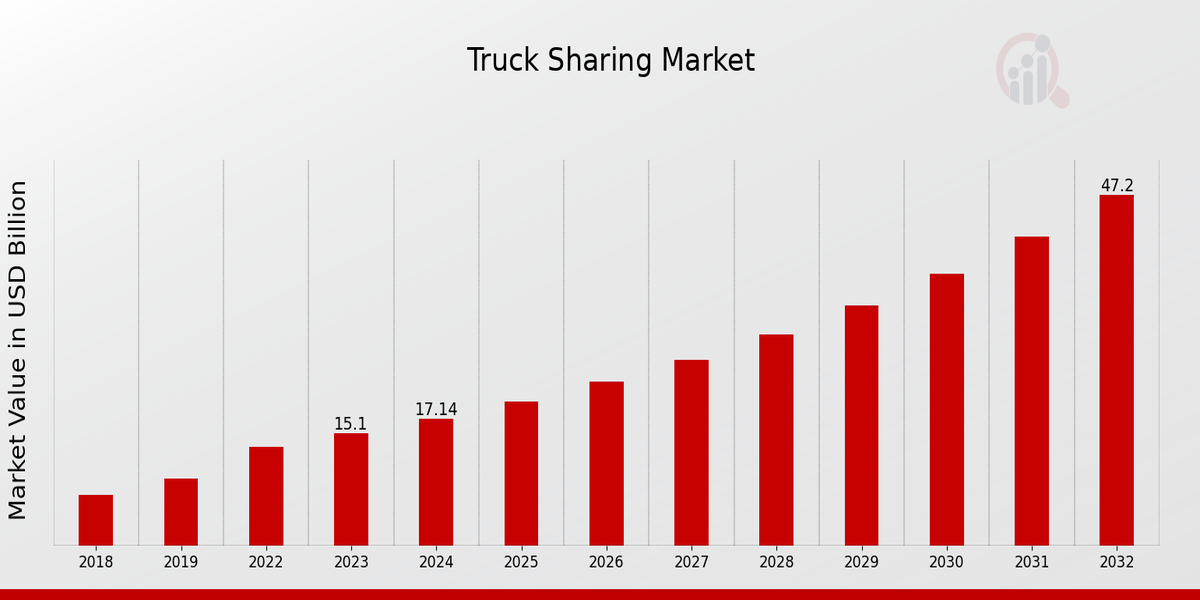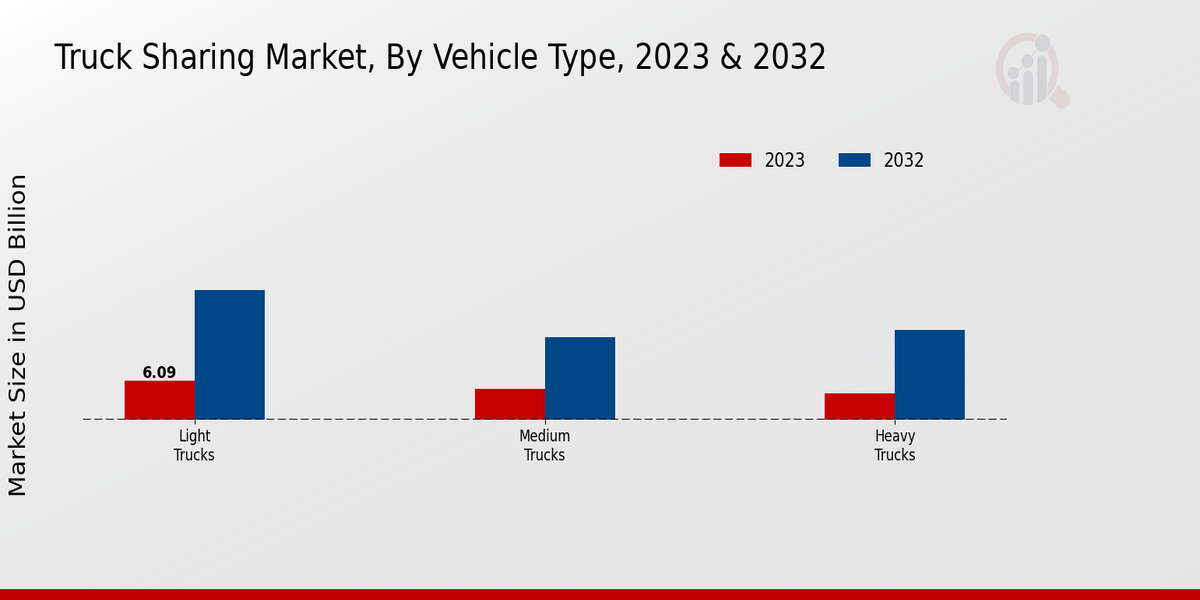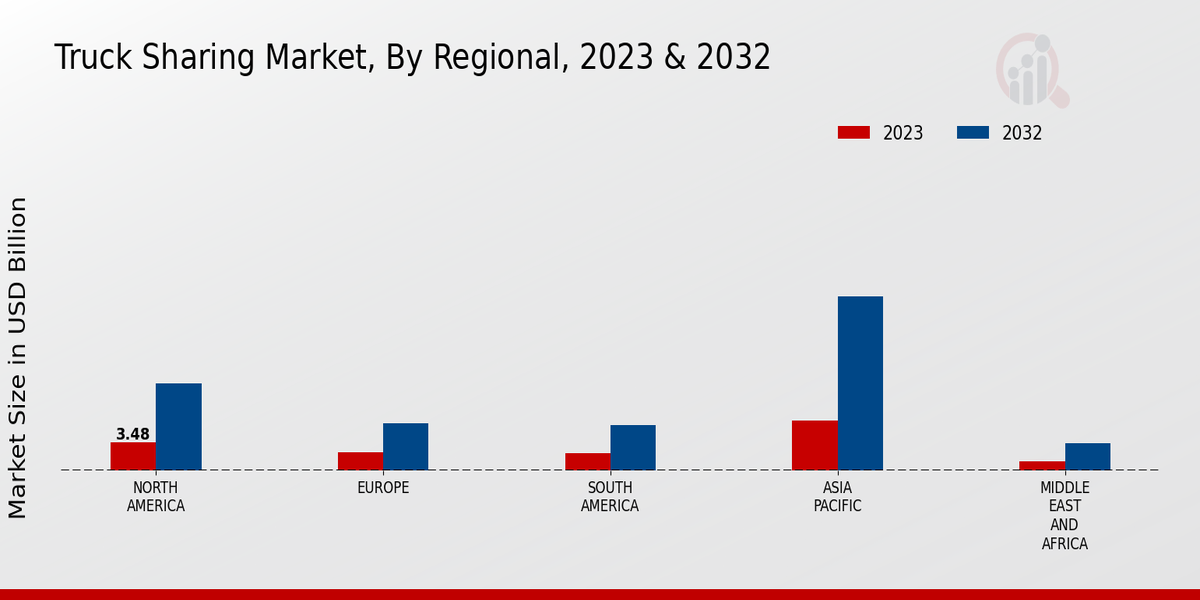Truck Sharing Market Overview:
As per MRFR analysis, the Truck Sharing Market Size was estimated at 19.47 (USD Billion) in 2024. The Truck Sharing Market Industry is expected to grow from 22.10 (USD Billion) in 2025 to 69.20 (USD Billion) till 2034, at a CAGR (growth rate) is expected to be around 13.52% during the forecast period (2025 - 2034).
Key Truck Sharing Market Trends Highlighted
The growing need for transport innovation imbued with mobility and affordability has led to phenomenal growth in the global Truck Sharing Market. The expansion of e-commerce and the development of last-mile delivery services, in turn, increased the necessity for rented on-demand truck services. Technological integration, such as GPS tracking and mobile applications, has added convenience and transparency to truck sharing platforms. Additionally, the growing emphasis on sustainability and the concern for green issues made truck sharing suitable for companies and end-users who want to minimize their carbon emissions.

Source: Primary Research, Secondary Research, MRFR Database and Analyst Review
Truck Sharing Market Drivers
Changing Regulatory Landscape
The increasing adoption of regulations that promote sustainable and efficient transportation is expected to fuel the growth of the Global Truck Sharing Market Industry. Governments worldwide are recognizing the environmental benefits of reducing truck emissions and traffic congestion. They are introducing regulations that encourage the adoption of innovative transportation solutions, such as truck sharing. For instance, the European Union (EU) has set ambitious targets for reducing greenhouse gas emissions in the transportation sector.The EU's Green Deal aims to reduce emissions by 55% by 2030 and achieve net-zero emissions by 2050. To achieve these targets, the EU is promoting the adoption of electric vehicles (EVs) and other sustainable transportation solutions. This has created a favorable environment for the growth of truck sharing, as it offers a more sustainable and cost-effective alternative to traditional truck ownership. The changing regulatory landscape is expected to remain a major driver of the Global Truck Sharing Market Industry in the coming years.
Increasing Demand for Flexible Transportation Solutions
The rising demand for flexible and cost-effective transportation solutions is another key driver of the Global Truck Sharing Market Industry. Businesses and individuals are increasingly seeking flexible transportation options that can meet their specific needs. Truck sharing provides a convenient and affordable solution for businesses that need to transport goods on a temporary basis. It also offers a cost-effective alternative to traditional truck ownership for individuals who do not require a truck on a regular basis.The increasing popularity of e-commerce and the growth of the logistics industry are further driving the demand for flexible transportation solutions, as businesses need efficient and reliable ways to deliver goods to customers.
Advancements in Technology
Rapid advancements in technology are also contributing to the growth of the global truck-sharing market. The development of mobile applications and platforms has made it easier for users to book and manage truck sharing services. Telematics and GPS technology are also being integrated into truck sharing platforms, which allows for real-time tracking and monitoring of trucks. These technological advancements have enhanced the convenience and efficiency of truck sharing, making it a more attractive option for businesses and individuals.
Truck Sharing Market Segment Insights:
Truck Sharing Market Vehicle Type Insights
Global Truck Sharing Market is divided by Vehicle Type into Light Trucks, Medium Trucks, and Heavy Trucks. Light Trucks are anticipated to have the largest market share in 2023 attributable to their versatility and cost-effectiveness. They are typically used for short-haul transportation and local deliveries. Medium trucks are projected to experience significant growth in the forecast period due to the increase in regional transportation and construction activities. The heavy duty trucks are expected to account for the major market share; they can be attributed in part to the growing demand for long-haul transportation and heavy firm applications.The market size for light trucks is projected to reach USD 5.2 billion by 2024 as it grows at a 12.5% CAGR.
Medium trucks are forecast to yield a market size a value of USD 4.1 billion in five years by growing at a CAGR of 13.2%. Though it has a lower market value compared with the two trucks, heavy trucks are anticipated to increase at the highest rate of 14.1%, yielding a market size of USD 3.6 billion by 2024. Some of the factors driving the growth of the Truck Sharing Market include increasing urbanization, rising e-commerce, and the demand for efficient transportation systems.Additionally, government regulations imposed on transportation companies have helped to increase the growth of the market by forcing truck owners to seek services that guarantee reduced transportation costs and time. Key contributors to the growth of the industry are forming partnerships, exploring emerging markets, and contributing to start-up companies in an effort to digitize the services they provide.
In January 2018, Amazon Inc. acquired an online truck marketplace company in a bid to expand its logistic portfolio by providing truck services.The established Amazon Truck Service Company, acts as an online intermediary connecting merchants with shippers in the US. Cisco Systems have developed a prototype that utilizes an IoT device that provides binary capabilities, allowing tracking, security maintenance, and optimization of truck fleet. In conclusion, increasing e-commerce, population, and heavy truck transportation needs across regions, are some of the factors driving the growth of the Truck Sharing Market.

Source: Primary Research, Secondary Research, MRFR Database and Analyst Review
Truck Sharing Market Usage Model Insights
The Global Truck Sharing Market is segmented by usage model into peer-to-peer, fleet-based, and subscription-based. Among these segments, the fleet-based model is expected to hold the largest market share in 2023, and is projected to continue its dominance throughout the forecast period. This growth can be attributed to the increasing adoption of fleet-based truck sharing services by businesses and organizations, as it offers advantages such as reduced operating costs, improved fleet utilization, and enhanced efficiency. The peer-to-peer segment is also expected to witness significant growth during the forecast period, owing to the rising popularity of peer-to-peer rental platforms and the increasing demand for flexible and cost-effective transportation solutions.
Truck Sharing Market Payload Capacity Insights
The Payload Capacity segment is a crucial aspect of the Global Truck Sharing Market segmentation, offering valuable insights into the market dynamics. Categorized into 'Less than 5 tons', '5-10 tons', and 'Over 10 tons', each segment holds a unique position in the industry. The 'Less than 5 tons' segment caters to light-duty transportation needs, exhibiting high demand for last-mile deliveries and urban logistics. With a projected revenue of $X billion in 2024, this segment is expected to witness significant growth due to the rising e-commerce industry and increasing urbanization.The '5-10 tons' segment holds a substantial market share, driven by its versatility in handling medium-duty transportation tasks. With a projected revenue of $Y billion in 2024, this segment serves various industries, including construction, manufacturing, and retail.
The growing demand for efficient and cost-effective transportation solutions fuels the growth of this segment. The 'Over 10 tons' segment caters to heavy-duty transportation requirements, such as long-haul freight and mining operations. Projected to generate $Z billion in revenue by 2024, this segment benefits from the increasing demand for bulk transportation services.Infrastructure development and industrial expansion contribute to the growth of this segment. Overall, the Payload Capacity segment provides a comprehensive understanding of the Global Truck Sharing Market, enabling stakeholders to make informed decisions and capitalize on growth opportunities.
Truck Sharing Market Application Insights
The Global Truck Sharing Market is segmented into various applications, including Construction, Transportation and Logistics, Retail and Distribution and Manufacturing. The Transportation and Logistics segment is expected to account for significant market share in 2023 and is projected to grow at a CAGR of 14.2% to reach USD 16.4 Billion by 2032. The growth in this segment is primarily attributed to the increasing demand for efficient and cost-effective transportation solutions for businesses. The Retail and Distribution segment is also expected to witness substantial growth over the forecast period, driven by the rise of e-commerce and the need for last-mile delivery services.The Construction and Manufacturing segments are expected to contribute to the overall market growth, supported by the increasing adoption of truck sharing services by businesses in these industries to optimize their operations and reduce transportation costs.
Truck Sharing Market Powertrain Insights
The powertrain segment in the global truck sharing market is expected to witness significant growth in the coming years, driven by rising demand for fuel-efficient and environmentally friendly vehicles. Diesel powertrains are likely to remain dominant, accounting for over 60% of the market share in 2023. However, electric and hybrid powertrains are gaining traction, driven by government regulations and incentives promoting sustainable transportation. The electric truck sharing market is projected to grow at a CAGR of over 15% during the forecast period, reaching a market size of USD 10 billion by 2032.Key market players are investing heavily in research and development to improve the performance and range of electric trucks, making them more attractive to consumers. Hybrid powertrains offer a balance between fuel efficiency and performance, and are expected to gain popularity in the medium-term.
Truck Sharing Market Regional Insights
The Global Truck Sharing Market is expected to witness significant growth in the coming years, driven by increasing urbanization, rising e-commerce penetration, and growing demand for flexible transportation solutions. Regionally, North America is projected to dominate the market in 2023, with a market revenue of around 6.9 billion U.S. dollars, owing to the presence of well-developed infrastructure, high disposable income, and a large number of logistics and transportation companies. Europe is expected to follow, with a market revenue of approximately 4.2 billion U.S.dollars in 2023.
The Asia-Pacific region is anticipated to exhibit the highest growth rate during the forecast period, owing to the rapid urbanization, increasing population, and growing middle class in countries such as China, India, and Indonesia. South America and the Middle East and Africa regions are expected to contribute a smaller share to the Global Truck Sharing Market but are expected to witness steady growth in the coming years.

Source: Primary Research, Secondary Research, MRFR Database and Analyst Review
Truck Sharing Market Key Players And Competitive Insights:
Major players in the Truck Sharing Market are constantly striving to maintain a competitive edge in the industry. Through strategic partnerships, joint ventures, and mergers and acquisitions, these companies aim to expand their market reach, enhance their service offerings, and gain a larger market share. The industry is marked by a mix of established players and emerging startups, each with its own unique strengths and strategies. These players are continuously investing in technology, expanding their fleets, and offering innovative solutions to meet the evolving needs of customers.One of the leading Truck Sharing Market industry players, Ryder System, Inc., has made significant investments in enhancing its technologies and digital capabilities.
The company offers a range of services, including dedicated transportation, supply chain management, fleet management, and commercial rental. Ryder's commitment to automation and data analytics has enabled it to streamline operations and improve efficiency, making it a preferred choice for businesses seeking reliable and comprehensive transportation solutions. The company's vast network and proven track record in the industry have positioned it as a formidable competitor in the Truck Sharing Market.Another key player in the Truck Sharing Market is Getaround, Inc., a technology-driven carsharing marketplace that has expanded its services to include commercial vehicles.
The company's mobile-first platform allows users to access a wide range of vehicles, including trucks, on a pay-as-you-go basis. Getaround's focus on convenience, flexibility, and cost-effectiveness has made it popular among individuals and businesses seeking affordable and efficient transportation options. The company's strategic partnerships with various organizations and its commitment to safety and customer service have contributed to its growing position in the Truck Sharing Market.
Key Companies in the Truck Sharing Market Include:
- Volvo Trucks
- Hertz Global Holdings
- Mitsubishi Fuso Truck and Bus Corporation
- Penske Truck Leasing
- Donlen
- Daimler Trucks North Americ
- Hino Motors
- Paccar
- Tata Motors
- Element Fleet Management
- Enterprise Holdings
- Navistar
- Isuzu Motors
- Ashok Leyland
- Ryder
Truck Sharing Industry Developments
The global truck sharing market is projected to grow from USD 15.1 billion in 2023 to USD 47.2 billion by 2032, at a CAGR of 13.5% during the forecast period. The rising demand for efficient and cost-effective transportation solutions, coupled with increasing urbanization and e-commerce growth, is driving the market expansion. Additionally, government initiatives promoting sustainable transportation and reducing carbon emissions further fuel market growth.
Recent developments include Daimler Truck's partnership with Waymo to develop autonomous trucks for long-haul transportation and Uber Freight's acquisition of Transplace, enhancing its digital freight brokerage capabilities. These developments indicate the industry's focus on innovation and technological advancements to meet the evolving needs of the logistics sector.
Truck Sharing Market Segmentation Insights
Truck Sharing Market Vehicle Type Outlook
- Light Trucks
- Medium Trucks
- Heavy Trucks
Truck Sharing Market Usage Model Outlook
- Peer-to-Peer
- Fleet-Based
- Subscription-Based
Truck Sharing Market Payload Capacity Outlook
- Less than 5 tons
- 5-10 tons
- Over 10 tons
Truck Sharing Market Application Outlook
- Construction
- Transportation and Logistics
- Retail and Distribution
- Manufacturing
Truck Sharing Market Powertrain Outlook
Truck Sharing Market Regional Outlook
- North America
- Europe
- South America
- Asia Pacific
- Middle East and Africa
| Report Attribute/Metric |
Details |
|
Market Size 2024
|
19.47 (USD Billion)
|
|
Market Size 2025
|
22.10 (USD Billion)
|
|
Market Size 2034
|
69.20 (USD Billion)
|
|
Compound Annual Growth Rate (CAGR)
|
13.52% (2025 - 2034)
|
|
Report Coverage
|
Revenue Forecast, Competitive Landscape, Growth Factors, and Trends
|
|
Base Year
|
2024
|
|
Market Forecast Period
|
2025 - 2034
|
|
Historical Data
|
2019 - 2023
|
| Market Forecast Units |
USD Billion |
| Key Companies Profiled |
Volvo Trucks, Hertz Global Holdings, Mitsubishi Fuso Truck and Bus Corporation, Penske Truck Leasing, Donlen, Daimler Trucks North Americ, Hino Motors, Paccar, Tata Motors, Element Fleet Management, Enterprise Holdings, Navistar, Isuzu Motors, Ashok Leyland, Ryder |
| Segments Covered |
Vehicle Type, Usage Model, Payload Capacity, Application, Powertrain, Regional |
| Key Market Opportunities |
Adoption in logistics sector Fleet management solutions Growing demand for on-demand services Partnerships with OEMs Technological advancements |
| Key Market Dynamics |
Ecommerce expansion Growing urban population Technological advancements Cost-effectiveness Government initiatives |
| Countries Covered |
North America, Europe, APAC, South America, MEA |
Frequently Asked Questions (FAQ) :
The global truck sharing market is expected to reach USD 69.20 billion by 2034, growing at a CAGR of 13.52% from 2025 to 2034.
North America is expected to hold the largest share of the global truck sharing market, accounting for 35.2% of the market in 2023.
The key factors driving the growth of the global truck sharing market include increasing demand for flexible and cost-effective transportation solutions, rising e-commerce and logistics activities, and growing urbanization.
Some of the key competitors in the global truck sharing market include Ryder System, Inc., Element Fleet Management Corp., Wheels Inc., Getaround, Inc., and Turo Inc.
The major applications of truck sharing include transportation of goods, moving and hauling, construction, and disaster relief.
The challenges facing the global truck sharing market include regulatory barriers, lack of awareness, and competition from traditional transportation services.
The future trends in the global truck sharing market include the adoption of electric and autonomous vehicles, the integration of technology, and the expansion of services to new markets.
The COVID-19 pandemic had a negative impact on the global truck sharing market in the short term due to lockdowns and travel restrictions. However, the market is expected to recover and continue to grow in the long term.

















